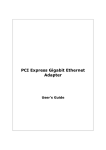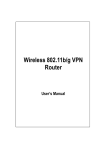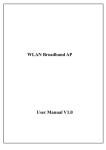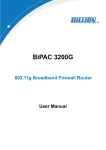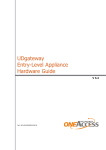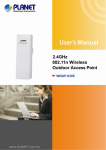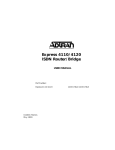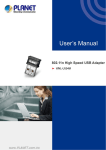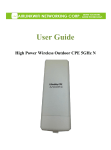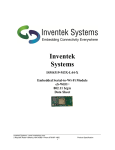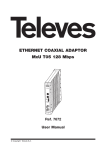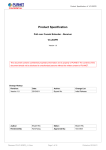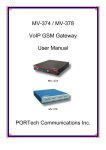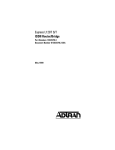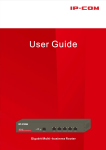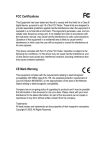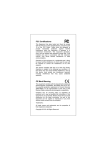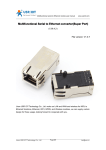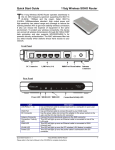Download IEEE802.11g Wireless Access Point with Client
Transcript
IEEE802.11g Wireless Access Point with Client User’s Manual FCC Certifications Federal Communication Commission Interference Statement This equipment has been tested and found to comply with the limits for a Class B digital device, pursuant to Part 15 of the FCC Rules. These limits are designed to provide reasonable protection against harmful interference in a residential installation. This equipment generates, uses and can radiate radio frequency energy and, if not installed and used in accordance with the instructions, may cause harmful interference to radio communications. However, there is no guarantee that interference will not occur in a particular installation. If this equipment does cause harmful interference to radio or television reception, which can be determined by turning the equipment off and on, the user is encouraged to try to correct the interference by one of the following measures: -Reorient or relocate the receiving antenna. -Increase the separation between the equipment and receiver. -Connect the equipment into an outlet on a circuit different from that to which the receiver is connected. -Consult the dealer or an experienced radio/TV technician for help. This device complies with Part 15 of the FCC Rules. Operation is subject to the following two conditions: (1) This device may not cause harmful interference, and (2) this device must accept any interference received, including interference that may cause undesired operation. FCC Caution: Any changes or modifications not expressly approved by the party responsible for compliance could void the user's authority to operate this equipment. IMPORTANT NOTE: FCC Radiation Exposure Statement: This equipment complies with FCC radiation exposure limits set forth for an uncontrolled environment. This equipment should be installed and operated with minimum distance 20cm between the radiator & your body. This transmitter must not be co-located or operating in conjunction with any other antenna or transmitter. IEEE 802.11b or 802.11g operation of this product in the U.S.A. is firmware-limited to channels 1 through 11. CE Mark Warning This equipment complies with the requirements relating to electromagnetic compatibility, EN 55022 class B for ITE, the essential protection requirement of Council Directive 89/336/EEC on the approximation of the laws of the Member States relating to electromagnetic compatibility. Company has an on-going policy of upgrading its products and it may be possible that information in this document is not up-to-date. Please check with your local distributors for the latest information. No part of this document can be copied or reproduced in any form without written consent from the company. Trademarks: All trade names and trademarks are the properties of their respective companies. Copyright © 2006, All Rights Reserved. Table of Contents Unpacking Information··········································· 1 Introduction ···························································· 2 General Description ········································································ 2 Key Features ················································································· 2 The Front Panel·············································································· 3 The Rear Panel··············································································· 4 Connecting This AP to Your Network. ···················· 5 Management························································ 6 Configuring the IP address of your computer ······································ 6 Starting the WEB-Based Management Interface ·································· 8 Status ························································································ 10 Items ·················································································· 10 Information·········································································· 10 LAN Interface Setup ····································································· 11 System Log ················································································· 12 Password Setup ··········································································· 13 Basic Settings ·············································································· 14 Advanced Settings········································································ 17 Security ······················································································ 19 WEP Encryption ···································································· 19 WPA Encryption ···································································· 20 WPA2 Encryption··································································· 21 WPA2 Mixed Encryption·························································· 22 Access Control ············································································· 23 Statistics····················································································· 24 Upgrade Firmware ········································································ 25 Save and Reload Settings ······························································ 26 Log out ······················································································· 26 Product Specifications ·········································· 27 Unpacking Information Thank you for purchasing the product. Before you start, please check all the contents of this package. The product package should include the following: 1. 2. 3. 4. One One One One Wireless AP power adapter User Manual (CD) detachable antenna 1 Introduction General Description Easily constructing your LAN, this wireless access point offers a wireless interface and eliminates your effort busying cabling form one computer to another. With being compliant to IEEE 802.11g specification, this wireless access point supports data rate up to 54Mbps and hence help to construct your high-speed home or office wireless network. 802.11g is also backward compatible with IEEE 802.11b wireless devices. This access point equips one LAN port and one embedding antenna. With supporting DHCP server and client, the W430 is easy to install and setup. The wireless security mechanism is provided over 64/128-bit WEP, WPA (TKIP with IEEE 802.1x), WPA2 and AES. This device supports WEB-based graphics user interface that helps users to configure this device easily. Key Features Complies with IEEE 802.11b/g wireless standards Provides one 802.11b/g wireless Reverse SMA detachable antenna High speed transfer data rate up to 54Mbps Supports turbo mode for 72Mbps data transfer Supports wireless data encryption with 64/128-bit WEP, WPA (TKIP with IEEE 802.1x), WPA2 and AES functions Supports one switch for selecting AP client mode or AP mode Supports Ad Hoc mode, Infrastructure mode, AP Bridge mode, AP Bridge WDS mode and Repeater mode Supports authentication for wireless connectivity based on ESSID Provides MAC access control and hidden SSID function WDS supported with WEP, TKIP and AES encryption Supports DHCP server Supports firmware upgrade function via Web Compliant with FCC Part 15.247 for US, ETS 300 328 for Europe Flash: 2MB, SDRAM : 8MB Certifications: FCC Class B, CE Mark 2 The Front Panel LED definition LED Status WALN LAN Status Definition Steady Blue Blinking Blue Off Blinking Blue Off Blinking Blue System down or System restarting System works normally. System down Wireless interface enabled Wireless interface disabled Data transmitting/receiving on LAN port Valid connection on LAN port Invalid connection on LAN port Steady Blue Off 3 The Rear Panel DC 12V Plug this connector with the circle end of the included power adapter. Plug the adapter to an outlet to power on the AP. AP/Client switch Push this switch to either side to function this AP in AP mode or Client mode. Restore Press and hold this button for 5 seconds to restore the default values. LAN The RJ-45 port for connect this AP to your LAN. 4 Connecting This AP to Your Network. This Chapter provides a step-by-step guide to the installation and configuration of this wireless access point. Connect the power adapter with the connector end to the power connector in the rear panel of the device and the plug end to an appropriate outlet. Connect the LAN port with RJ-45 cable to: 1. a broad band router to allow wireless clients to connect to WAN. 2. a switch to allow wireless clients to communicate with wired LAN. 3. a computer directly to use the computer configuring this AP. Note: You have to configure the network settings of this AP to be communicable with your router, switch or computer first. To change the default network settings of the AP, please refer to “LAN Interface setup”. 5 Management Configuring the IP address of your computer In order to manage with this Wireless AP, you have to configure the IP addresses of your computer to be compatible with this device. Note: 1. The default network setting of the device: IP address: 192.168.1.1 Subnet Mask: 255.255.255.0 Default Gateway: 192.168.1.254 2. 3. In the following TCP/IP configuration guide, the IP address “192.168.1.2 ” is assumed to be your IP address. Please DO NOT choose 192.168.1.1 for the IP address (192.168.1.1) has been set as the default IP for this device. The following TCP/IP configuration guide uses windows XP as the presumed operation system. Procedures to configure IP addresses for your computer 1. 2. If you are in Classic Start menu view, click Start Settings Control Panel Network Connections. If you are in Start menu view, click Start Control Panel Network Connections. Double click “Local Area Connection” 6 3. Choose Internet Protocol (TCP/IP) and click Properties. 4. Choose “Use the following IP address” to specify IP addresses manually. Fill in the IP addresses in each column. Please click the OK button after your configuration. 7 Starting the WEB-Based Management Interface The device uses WEB as the management interface. You can use a browser to access the management interface easily. Please follow up the steps listed below. 1. Double click the Internet WEB browser icon on your desktop screen (Netscape Communicator 4.0 and Internet Explorer 3.0 or update version) 2. Type 192.168.1.1 into the URL WEB address location and press Enter. 3. The Username and Password Required window appears. Enter admin in the User Name location (default value). Enter admin in the Password location (default value). Click “OK” button 8 The Graphic User Interaface After the password authorization, the Setup Wizard shows up as the home page of the Graphic User interface. You may click on each folder on left column of each page to get access to each configuration page. 9 Status The Status page shows the following information of the device. Items Uptime Firmware version Mode Band SSID Channel Number Encryption BSSID Associated Clients Attain IP Protocol IP Address Subnet Mask Default Gateway MAC Address Information The period that you turn the device on. The current firmware version of the device. Shows if the device is operating in AP or WDS mode. The band that the wireless AP operating. The name of this wireless network. The channel that the wireless network using. The security encryption type that the wireless network using. The Basic Service Set Identity of this AP(This parameter is the same as the MAC address of LAN port) The number of members who is currently connected with this AP. The way for this AP to get a IP address. The current IP address of this AP. The current subnet mask of this AP. The current default gateway of this AP. The current MAC address of this AP. 10 LAN Interface Setup This page allows users to configure the LAN network settings. Configuration IP address The IP of your AP LAN port (Default 192.168.1.1) Subnet Mask Subnet Mask of you LAN (Default 255.255.255.0) Default Gateway The default gateway of this AP. DHCP Server Select “Enable” to enable the DHCP server. DHCP Client Range Specify the DHCP Client IP address range. You can also click the “Show Client” button to list those connected DHCP clients. DNS Server The DNS (domain name server) of this AP. Domain Name The name that the AP is going to be recognized in LAN. 802.1d Spanning To prevent from network loops and preserve the quality of tree bridged network MAC cloning feature allows the MAC address reported by WAN side network interface card to be set to the MAC address already registered with the ISP eliminating the need to Clone MAC register the new MAC address with the ISP. This feature does Address not change the actual MAC address on the NIC, but instead changes the MAC address reported by this device to client requests. To Change the MAC address, enter it in the text box. 11 System Log This System Log page shows the information of the current activities on the AP. To enable system log function: 1. 2. 3. Mark the “Enable Log” checkbox. To see all information of the system, select the “system all” checkbox. To see wireless information only, select the “wireless” checkbox. To send the log information to a certain note, select the “Enable Remote Log” checkbox and fill in the IP address in the “Log Server IP Address” box. Click the “Apply Changes” button to activate You could also click the “Refresh” button to refresh the log information or click the “clear” button to clean the log table. 12 Password Setup This page allows users to configure the username and password for getting accessed to this WEB based user interface. To change the username/password, please fill in the username, New password and click the “Apply Changes” button after confirming the password. You may also cancel the password authentication by leaving those blanks empty then clicking the “Apply Changes” button. 13 Basic Settings This page provides setting up the wireless configuration and monitoring the Wireless Clients that associate with this AP. Configuration Disable Wireless To Disable interface of Wireless LAN LAN Interface Band To select a band for this device to match 802.11b, 802.11g or both. AP Mode Type Configure this device as AP, WDS or both. SSID The name of the wireless network Country Select the region you live. Channel Number The channel used by the wireless LAN. All devices in the same wireless LAN should use the same channel. Associated Clients Click the "Show Active Clients" button, then an "Active Wireless Client Table" will pop up. You can see the status of all active wireless stations that are connecting to the access point. 14 WDS Setting Enable Universal Repeater Mode Root AP SSID Click the “Show WDS Setting” button to configure WDS settings. The WDS settings pops up. Mark this checkbox to enable Universal Repeater Mode which acts this device as an AP and client simultaneously. While you enable the Universal Repeater Mode, you have to specify an SSID for the extended interface. Click <Apply changes> button at the bottom of the screen to save the above configurations. You can now configure other advance sections or start using the AP (with the advance settings in place) Active Wireless Client Table This is the window that pops up after clicking the “Show Active Clients” button. MAC Address MAC address of this active wireless station. Tx Packet The number of transmitted packets that are sent out from this active wireless station. Rx Packet The number of received packets that are received by this active wireless station. TX Rate The transmission rate Power Saving Shows if the wireless client is in Power Saving mode Expired Time This is the time in second before dissociation. If the wireless keeps idle longer than the expired time, this wireless AP will dissociate it. The wireless client station has to associate again when it is active. 15 Refresh Refresh the "Active Wireless Client Table". Close Close the "Active Wireless Client Table". WDS Settings This is the window that pops up after clicking the “Show WDS Setting” button. Wireless Distribution System allows this AP to communicate with other APs wirelessly. To make it work, you must ensure that these APs are in the same Channel and add these APs MAC Address and Comment values into the WDS list. Don’t Forget to Enable the WDS by click the check box of “Enable WDS” and press “Apply Changes” button to save. To Delete the AP on the list, Click the check box in the select item and click the “Delete Selected”. If you want to delete all APs on the list, click “Delete All” to remove all of them. 16 Advanced Settings You can set advanced wireless LAN parameters of this AP. The parameters include Authentication Type, Fragment Threshold, RTS Threshold, Beacon Interval, Data Rate, Preamble Type, Broadcast SSID, IAPP and 802.11g Protection. Configuration Open System Allow communication with no security. mode Authentication Type Fragment Threshold Shared Key mode Allow communication with devices with the same WEP key only. Auto The wireless client can associate with this AP by using any one of these two Modes. To specifies the maximum size of packet during the data transition. The lower values you set, the worst performance it will be. 17 RTS Threshold If the packet size is smaller the RTS threshold, the AP will not send this packet by using the RTS/CTS mechanism. Beacon Interval The period of time how long a beacon is broadcasted. Data Rate The "Data Rate" is the data packets limitation this wireless AP can transmit. The wireless AP will use the highest possible selected transmission rate to transmit the data packets. It defines the length of CRC block in the frames during the wireless communication. "Short Preamble" is suitable for Preamble Type heavy traffic wireless network. "Long Preamble" provides much communication reliability If you enable "Broadcast SSID", every wireless station located within the coverage of this wireless AP can discover Broadcast SSID this wireless AP easily. If you are building a public wireless network, enabling this feature is recommended. Disabling "Broadcast SSID" can provide better security. IAPP To enables multiple AP to communicate and pass information regarding the location of associated Stations. 802.11g Protection Some 802.11g wireless adapters support 802.11g protection, which allows the adapters searches for 802.11g singles only. Select the “Disabled” to disable supporting 802.11g protection or select “enable” to support this function. RF Output power Select the RF (Radio Frequency) power. The RF output power has positive correlation with signal strength. Turbo Mode Some of our wireless adapters supports turbo mode, which provides a better connection quality. Select “Always” to support turbo mode or select “off” to turn it off . Select “Auto” turns it on or off automatically. Click the <Apply Changes> button at the bottom of the screen to save the above configurations. You can now configure other advance sections or start using the AP. 18 Security At the page, you can set up the WEP, WPA Encryption to ensure the security of your Wireless. You will have to do different configurations to each encryption modes. Click on the Encryption drop list to select an encryption mode or select “Disabled” to transmitting data without encryption. WEP Encryption Configuration Encryption To enable WEP, WPA, WPA2 and WPA2 Mixed encryption modes, select the option in the drop list. If you select none, any data will be transmitted without Encryption and any station can access the AP Key Length Select a key length as 64-bit or 128-bit. Key Format Select a key format as Hex or ASCII Default Tx Key Select a default key for transmitting data. Use 802.1x Authentication Mark this check box. Fill in the RADIUS server IP address, Port Number, and Password to enable 802.1x authentication. Click <Apply Change> at the bottom of the screen to save the above configurations. You can now configure other advance sections or start using the AP. 19 WPA Encryption Configuration Encryption To enable WEP, WPA, WPA2 and WPA2 Mixed encryption modes, select the option in the drop list. If you select none, any data will be transmitted without Encryption and any station can access the AP. WPA Cipher Suite Select the WPA Cipher Suite to be TKIP or AES WPA Authentication Mode Select the WPA mode as “Enterprise (WPA-Radius)” or “Personal (Pre-Shared Key)”. Pre-Shared key Format Click on the drop list to select an Pre-Shared Key Format as Passphrase or Hex Pre-shared Key Enter the Pre-shared Key according to the pre-shared key format you select. Click <Apply Change> at the bottom of the screen to save the above configurations. You can now configure other advance sections or start using the AP. 20 WPA2 Encryption Configuration Encryption To enable WEP, WPA, WPA2 and WPA2 Mixed encryption modes, select the option in the drop list. If you select none, any data will be transmitted without Encryption and any station can access the AP. WPA2 Cipher Suite Select the WPA2 Cipher Suite to be TKIP or AES WPA Authentication Mode Select the WPA mode as “Enterprise (WPA-Radius)” or “Personal (Pre-Shared Key)”. Pre-Shared key Format Click on the drop list to select an Pre-Shared Key Format as Passphrase or Hex Pre-shared Key Enter the Pre-shared Key according to the pre-shared key format you select. Click <Apply Change> at the bottom of the screen to save the above configurations. You can now configure other advance sections or start using the AP. 21 WPA2 Mixed Encryption Configuration Encryption To enable WEP, WPA, WPA2 and WPA2 Mixed encryption modes, select the option in the drop list. If you select none, any data will be transmitted without Encryption and any station can access the AP. WPA Cipher Suite Select the WPA Cipher Suite to be TKIP or AES WPA2 Cipher Suite Select the WPA2 Cipher Suite to be TKIP or AES WPA Authentication Mode Select the WPA mode as “Enterprise (WPA-Radius)” or “Personal (Pre-Shared Key)”. Pre-Shared key Format Click on the drop list to select an Pre-Shared Key Format as Passphrase or Hex Pre-shared Key Enter the Pre-shared Key according to the pre-shared key format you select. Click <Apply Change> at the bottom of the screen to save the above configurations. You can now configure other advance sections or start using the AP. 22 Access Control To restrict the Number of Access authentication of Stations, Set up the control list in this page. Configuration Wireless Access Control Mode Click on the drop list to choose the access control mode. You may select “Allow listed” to allow those allowed MAC addresses or select “Deny Listed” to ban those MAC addresses from accessing to this device. MAC Address & Comment To set up the Value of MAC Address & Comment; enter the MAC Address and Comment of station and click Apply Changes to save. Current Access Control list To Delete the station on the list, Click the check box in the select item and click the “Delete Selected”. If you want to delete all stations on the list, click “Delete All” to remove all of them. Click <Apply Change> button to save the above configurations. You can now configure other advance sections or start using the AP. 23 Statistics On this page, you can monitor the sent & received packets counters of wireless, Ethernet LAN, and Ethernet WAN. To see the latest report, click refresh button. 24 Upgrade Firmware To Upgrade Firmware, STEPS 1. Click “browse…” button to select the firmware you want to upgrade. 2. Click Upload to start the upgrade process. Please don’t close the WEB-browser and wait for the process to be completed. 25 Save and Reload Settings To save setting to file, click “Save...” button. To load setting from file, 1. Click “Browse…” on the to select the file 2. Click upload to start the process and wait for it to complete To reset setting to Default, click the Reset button to start the process. Log out Click the “Apply Change” button to log out the system and save your changes simultaneously. 26 Product Specifications Standard Interface Cable Connections Network Data Rate IEEE802.3, 10BASE-T IEEE802.3u, 100BASE-TX IEEE802.3x full duplex operation and flow control IEEE802.11b wireless LAN infrastructure IEEE802.11g wireless LAN infrastructure 1 * LAN port Antenna: 802.11b/g wireless reverse SMA detachable RJ-45 (10BASE-T): Category 3,4,5 UTP RJ-45 (100BASE-TX): Category 5 UTP 802.11b: 1, 2, 5.5 and 11Mbps 802.11g: 6, 9, 12, 18, 24, 36, 48, and 54Mbps Transmission Mode Auto-Negotiation (Full-duplex, Half-duplex) LED indications 1*Power, 1*WLAN, 1*LAN Security Receiver Sensitivity 64/128-bit WEP, WPA(TKIP with IEEE 802.1x), WPA2, AES 54Mbps OFDM, 10%PER, -68dBm 11Mbps CCK, 10%PER, -86dBm 1Mbps BPSK, 10%PER, -93dBm Memory Flash : 2MB, SDRAM : 8MB Transmit Power 16dBm~18dBm Range Coverage Indoor 30m at 54Mbps Outdoor 61m at 54Mbps. Emission FCC CLASS B, CE Environmental Operating Temperature: 0° ~ 40°C (32° ~ 104°F) Storage Temperature: -10° ~ 70°C (-14° ~ 140°F) Humidity: 10 ~ 95% RH non-condensing Power Supply External Power Adapter, 12VDC/ 1A 27 61NB-04300+207C































